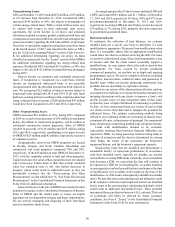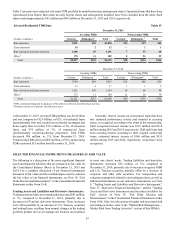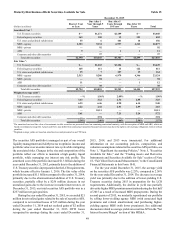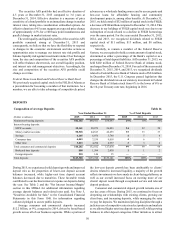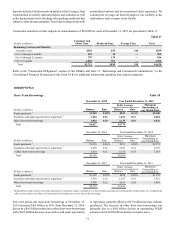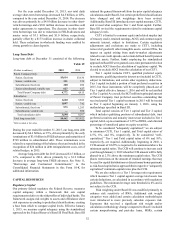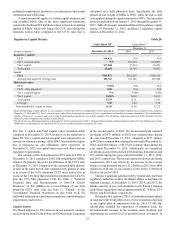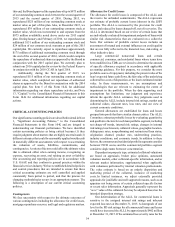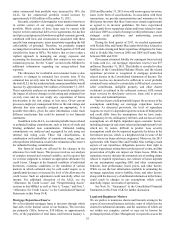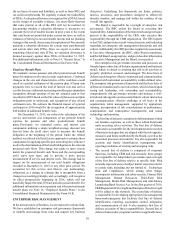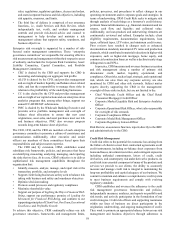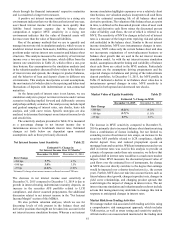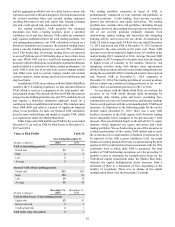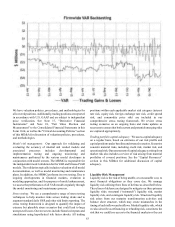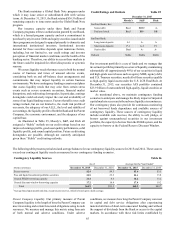SunTrust 2015 Annual Report Download - page 84
Download and view the complete annual report
Please find page 84 of the 2015 SunTrust annual report below. You can navigate through the pages in the report by either clicking on the pages listed below, or by using the keyword search tool below to find specific information within the annual report.
56
probability of loss and amount of such loss, if any, in preparing
our financial statements.
We evaluate the likelihood of a potential loss from legal or
regulatory proceedings to which we are a party. We record a
liability for such claims only when a loss is considered probable
and the amount can be reasonably estimated. The liability is
recorded in other liabilities in the Consolidated Balance Sheets
and the related expense is recorded in the applicable category of
noninterest expense, depending on the nature of the legal matter,
in the Consolidated Statements of Income. Significant judgment
may be required in determining both probability of loss and
whether an exposure is reasonably estimable. Our estimates are
subjective based on the status of the legal or regulatory
proceedings, the merits of our defenses, and consultation with
in-house and outside legal counsel. In many such proceedings,
it is not possible to determine whether a liability has been
incurred or to estimate the ultimate or minimum amount of that
liability until the matter is close to resolution. As additional
information becomes available, we reassess the potential liability
related to pending claims and may revise our estimates.
Due to the inherent uncertainties of the legal and regulatory
processes in the multiple jurisdictions in which we operate, our
estimates may be materially different than the actual outcomes,
which could have material effects on our business, financial
condition, and results of operations. See Note 19,
“Contingencies,” to the Consolidated Financial Statements in
this Form 10-K for further discussion.
Estimates of Fair Value
The objective of a fair value measurement is to use market-based
inputs or assumptions, when available, to estimate the price that
would be received to sell an asset or paid to transfer a liability
in an orderly transaction between market participants at the
measurement date. When observable market prices from
transactions for identical assets or liabilities are not available,
we evaluate pricing for similar assets or liabilities. If observable
market prices for such assets or liabilities are unavailable or
impracticable to obtain, we look to other techniques for
estimating fair value (for example, obtaining third party price
quotes or using modeling techniques such as discounted cash
flows). The resulting valuation may include significant
judgments particularly when the market for an asset or liability
is not active.
Fair value measurements for assets and liabilities that
include significant inputs that are not observable in the market
are required to be classified as level 3 in the fair value hierarchy.
We have instituted various processes and controls surrounding
these measurements to ensure appropriate methodologies are
utilized. We continue to maintain a cross-functional approach
when estimating the fair value of these difficult to value financial
instruments. This includes input from not only the related line
of business, but also from risk management and finance, to
ultimately arrive at an appropriate estimate of the instrument's
fair value. This process involves the gathering of multiple
sources of information, including broker quotes, values provided
by pricing services, trading activity in other similar instruments,
market indices, and pricing matrices.
Modeling techniques incorporate our assessments regarding
assumptions that market participants would use in pricing the
asset or the liability, including assumptions about the risks
inherent in a particular valuation technique. These assessments
are inherently subjective; the use of different assumptions could
result in material changes to these fair value measurements. We
employed significant unobservable inputs when estimating fair
value for certain trading assets, securities AFS, portfolio loans
accounted for at fair value, IRLCs, LHFS, MSRs, and certain
derivatives.
We record all MSRs at fair value on a recurring basis. The
fair value of MSRs is based on discounted cash flow analyses
and can be highly variable quarter to quarter as market conditions
and projected interest rates change. We provide disclosure of the
key economic assumptions used to measure MSRs and residual
interests and a sensitivity analysis to adverse changes to these
assumptions in Note 9, “Goodwill and Other Intangible Assets,”
to the Consolidated Financial Statements in this Form 10-K. This
sensitivity analysis does not take into account hedging activities
discussed in the “Other Market Risk” section of this MD&A.
Overall, the financial impact of the level 3 financial
instruments did not have a material impact on our liquidity or
capital. Our holdings of level 3 financial instruments continues
to decline due to paydowns, sales, and settlements of these
instruments. Table 21 discloses assets and liabilities measured
at fair value on a recurring basis that are classified as level 3
measurements.
Level 3 Assets and Liabilities Table 21
December 31
(Dollars in millions) 2015 2014
Trading assets and derivatives 1$110 $25
Securities AFS 556 946
LHFS 51
LHFI 257 272
MSRs 1,307 1,206
Total level 3 assets $2,235 $2,450
Total assets $190,817 $190,328
Total assets measured at fair value on a
recurring basis 37,002 36,342
Level 3 assets as a % of total assets 1.2%1.3%
Level 3 assets as a % of total assets
measured at fair value on a recurring basis 6.0%6.7%
Trading liabilities and derivative instruments $6 $5
Other liabilities 23 27
Total level 3 liabilities $29 $32
Total liabilities $167,380 $167,323
Total liabilities measured at fair value on a
recurring basis 2,259 2,537
Level 3 liabilities as a % of total liabilities —%—%
Level 3 liabilities as a % of total liabilities
measured at fair value on a recurring basis 1.3%1.3%
1 Includes IRLCs.
Level 3 trading assets and derivatives increased by $85 million
during the year ended December 31, 2015, primarily due to the
addition of bonds that are not actively traded in the market; as
such, observable market data for these instruments is limited.
Level 3 securities AFS decreased by $390 million during the year
ended December 31, 2015 due primarily to the redemption of
FHLB stock as well as continued paydowns and sales on
securities AFS. During the year ended December 31, 2015, we


